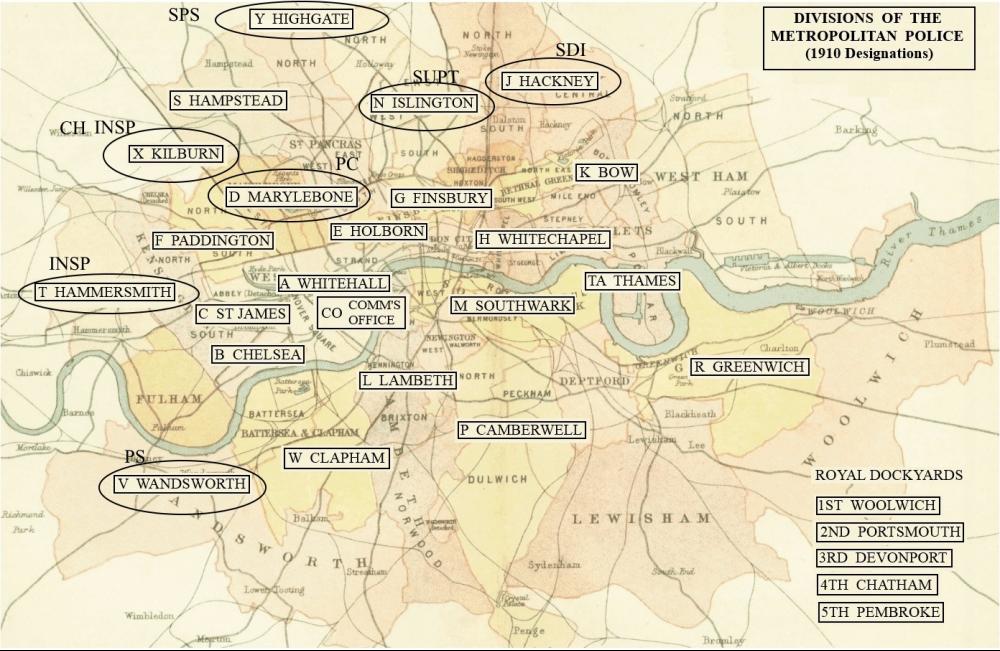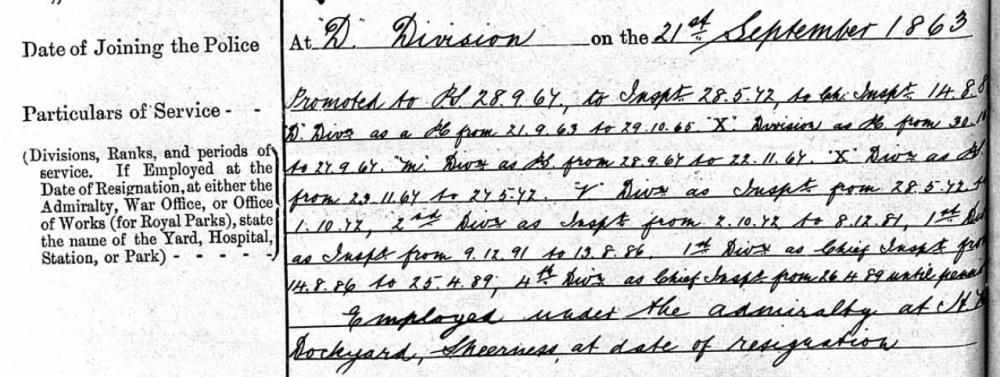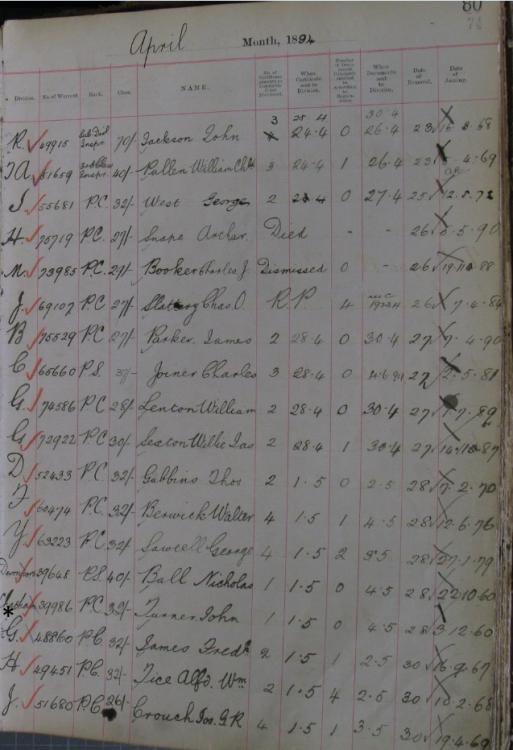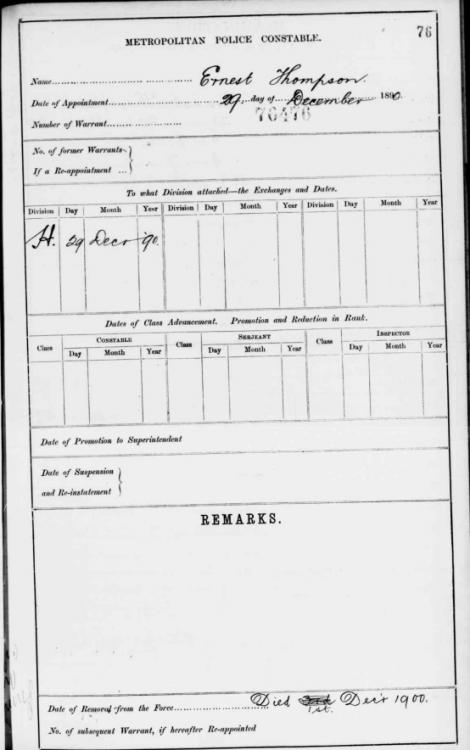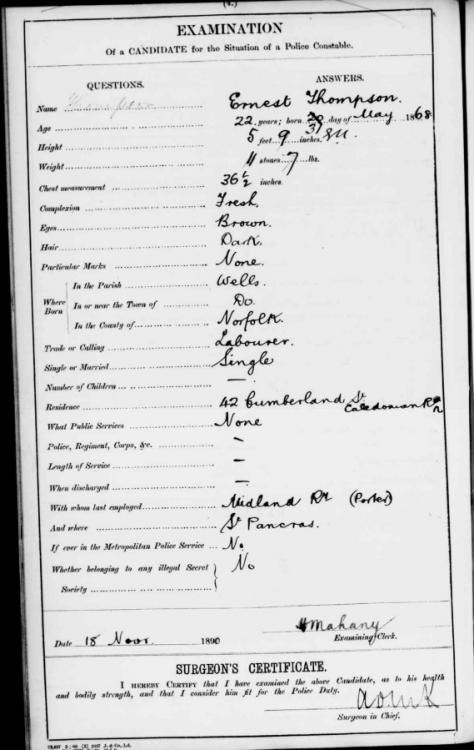-
Posts
276 -
Joined
-
Last visited
Content Type
Profiles
Forums
Blogs
Gallery
Events
Store
Everything posted by Odin Mk 3
-
There are also two candidates for the other photo Francis Markham joined as a PC in N Div 8/5/1882 and was pensioned 30/5/1907 as a PC in C Div (328C) - Warrant Number 66527 (he had served most his career in N Div) George Dendle joined C Div as a PC 14/04/1884 and was pensioned 26/04/1909 as a P)C in C Div (328C) - Warrant Number 69112 Again not possible to be 100% sure. So clearly this is not a precise science.
-
I have identified two officers who retired between 1902 and 1911 who had the collar number 123C - both are entitled to 1887 and bar and 1902 Medals. First is William Lavers Warrant Number 64277. He joined C Div 9/2/1880 as a PC and retired 12/2/1906 still a PC in C Div (Divisional Number 123C) The second is Albert Gunn Warrant Number 68571. He joined C Div 13/8/1883 as a PC and retired 16/9/1909 still a PC in C Div (also 123C) I would suggest Gunn was given the number 123C after Lavers left and therefore only held it for three years. It was quite common for older officers to be given lower numbers as they became available - that's probably what happened here. Sorry I can't identify it any closer than that. Will look at the other man next. I must stress that my book won't help you solve this sort problem - the first draft had divisional numbers as well but they were taken out to make all the information fit on a portrait format page. However I have an idea which I will be start exploring once I have looked at the other man.
-
Sorry I haven't been on the Forum for a while. The last (blank) post was just clearing something I couldn't delete from my reply box. There are several W Reids who earned 1911 Medals - however the only likely man to have earned the 1911 Coronation and 1935 Jubilee Medals AS A MET POLICEMAN is Warrant Number 99163 PC William Reid who joined K Div (Bow) 10/10/1910 and retired as a PC in X Div (Kilburn) 14/10/1935. So he was still serving in 1935 at the time the Jubilee Medal was awarded. All the other W Reids had left the Met long before that. Sadly there are no service sheets for him (he joined too late for those in Kew) but there will be a Central Record of Service (available by e-mail from the Met Police Heritage Centre for a small fee). However I have just checked the 1935 Jubilee Roll and I was surprised that I can't find him - this seems rather strange as most 1911 Medal holders who were still serving in 1935 also got the Jubilee Medal. The roll I have is copied from the alphabetical list (also held on the open shelves at The National Archives at Kew) and it may be this name was missed out when they were transcribed from the hundreds of lists which were submitted by individual departments etc (The Police are in Section 6 with has no less than132 rolls to cover all the various forces).
-
Yes I have that group photo thanks William Parker joined the Met 2/5/1887 as a PC in D Division (Marylebone) with the Warrant Number 72533. By 1902 he was a PS in V Div (Wandsworth) and in Oct that year he was promoted to Station Sergeant and moved to Y Div (Highgate). In Feb 1904 he became an Inspector in T Div (Hammersmith) and was promoted to Sub Divisional Insp in J Div (Hackney) in Dec 1906. In Feb 1911 he moved to X Div (Kilburn) as Chief Inspector and in June 1918 was made Supt in charge of N Division (Islington). I'm not sure when he retired but he had definitely left sometime before 1929. He had certainly moved around London during his career. His medals will be named 1887 PC D Div, 1902 PS V Div, 1911 Ch Insp.
-
Just seen this thread has resurfaced I have the 1902 medal to Richard Rickett (named to Ricketts) who is on that photo (middle row - fourth from left). All through his career they appear to have spelt his name wrong. In 1902 Rickett was a PS in C Div but had previously served as a PC in X Div. He was then a Station PS in Y Div before moving back to X Div as an Inspector in June 1909.
-
I think PC J James is John James who joined G Div 5/12/1881 and then transferred to Y DIv (Highgate) some time in before 1897 - he was pensioned (still a PC at Y Div) 30/06/1906. He is also entitled to a 1902 Coronation Medal (PC Y Div). They could be father and son but I couldn't find a match in a quick check of the 1871 and 1881 Censuses
-
'Last week I went to Kew but could not find Jo, in MEPO, but I was told the pension records do not actually contain post service info so gave up.' The Pension files are in the MEPO 21 series. I haven't used them very often but the ones I have seen all have service information. A good example is shown below for Ch Insp Joseph Wootton who retired in the 1890s. It shows all his moves and his promotions. I have transcribed the information I learnt from it here to make it easier to read: 21/09/1863 PC D Div 30/10/1865 PC X Div 28/09/1867 PS M Div 23/11/1867 PS X Div 28/05/1872 Insp V Div 02/10/1872 Insp 2nd Div 09/12/1881 Insp 1st Div 14/08/1886 Ch Insp 1st Div 26/04/1889 Ch Insp 4th Div 26/12/1892 Pensioned (last serving at Sheerness Dockyard)
-
Percy Burnage joined 18/12/1911 as a PC in F Division (Paddington) with the Warrant Number 100871and was discharged from X Division (Kilburn) 20/03/1935 as unfit and awarded a pension. His conduct was marked as exemplary. There should be a CRS for him (Central Record of Service) which I believe are held by the Police Heritage Centre not The National Archives. They are more detailed than the service sheets and show commendations and disciplinary offences. The page from the discharge register is attached - I will come back on the point of pension records when I have located a suitable example to add.
-
J Div (original called Bethnal Green) was formed in 1886 which is probably when he joined from neighbouring N Division). J Division had Police stations in Bethnal Green, Dalston, Hackney, Victoria Park, Wanstead, Leyton, Leytonstone, Barkingside, Woodford, Longhton and Chigwell (Sub Divisional Stations shown underlined) but yes West Ham had a Sub Divisional Police Station in neighbouring K Div. S Div had a Sub Divisional Station at Hampstead and a further police station at West Hampstead. Unfortunately without finding paylists (which I'm not sure many even exist now) you can never be sure exactly where a man was serving. I am aware of a few for 1891 but none cover any of these divisions.
-
Was he a PS in 1902? If so he is Arthur William Brown. His Warrant Number was 70412 and he joined as a PC in R Div (Greenwich) 13/04/1885 and was pensioned 18/04/1910 as a PS in S Div (Hampstead). He was promoted to PS and moved from J Div (Hackney) to S Div some time before 1897 as he was already a PS in S Div at the time of the 1897 Jubilee. I can also tell you that he moved to J Div 28/07/1886, having transferred from N Div (Islington), so he served in (at least) R Div, N Div, J Div and then S Div (the last as a PS).
-
These is no easy answer to your question. There are a number of sources of information that can be obtained - some can be downloaded for free from The National Archives website while others require a visit to Kew to access the information (usually because it hasn't been digitised). Plus there are the Met Police Orders but finding stuff in these is a needle in a haystack job. The Attestation Registers that are relevant to these medals are only held from Warrant No 51491 and show when an officer joined, which division he went to and give his signature to show he swore the oaths on joining. The Discharge Registers start from March 1889 and show when a man left (and why) and give his class of conduct plus which division he was serving when he left. The Service Sheets cover from Warrants 74201 to 97500 and give details of the man's previous employment and show briefly his career in the Met (moves and promotions etc). There are also pension records which cover men who left with a pension but these are not on line and need a visit to Kew to inspect them. They do include a summary of his career. There are also CRSs (Central Record System cards) for officers who were still serving in the 1930s - therefore only a few men who have police medals are included in these but they are the most detailed as they also show commendations and disciplinary offences - these can be obtained from the Police Historical Section for a small fee (and can be e-mailed to you). So the easiest source to access is the Service Sheets but as I said above they only cover a range of officers. For other men you have to piece it together rather like a jigsaw.
-
He should have a pension record which will be at The National Archives - probably in MEPO 21/23 (1893-94) but if not it will be in MEPO 21/24 (1894-95). Unfortunately these files have not been digitised and require a trip to Kew to view them. Normally the pension record has a very brief career summary which will show all the divisions the man served in. For men who joined later (Warrant No 51491 onwards) you can find which division they started in from the Attestation Registers but the copies available start after James joined.
-
No sorry I don't know where the section houses were but occasionally I have found one when looking for a PC on the census and note there is a group of Met Police all living in the same place. But it is possible that section houses near the boundaries of two divisions may well have had officers from more than one division billeted there. You also sometimes find some section houses were attached to Police Stations as the inhabitants shown on the census also can include prisoners held in the cells. I suspect you have the right man a there weren't many F James's in the Met Police, only one other around 1891 so I think you probably have found your man. Please note that in 1902 a Pensioner called Frederick James re-joined for the 1902 Coronation and probably got the 1902 Medal. More importantly he went to G Div - so I suspect it was your man. Note no PC Frederick James re-joined for the 1897 Jubilee.
-
There were three Police Stations in G Division (each was classed as a Sub Divisional Station which was run by a Sub Divisional Inspector who was a higher grade than an Inspector - above them were one Supt and one Chief Inspector for the whole Division). The stations were (in 1882 and 1895): King's Cross Road, Clerkenwell Old Street, St Luke's Kingsland Road, Hoxton Physically the nearest Police Station in G Div to Holborn was King's Cross Road The best way to find out which station he was based at would be to find some weekly pay lists which show which station each officer was based at. Unfortunately there are only a few samples in The National Archives covering one week in April 1891 - these show Y Div (Highgate), 4th Div (Chatham & Sheerness Dockyards) and 5th Div (Pembroke Dockyard). There must be more somewhere but I've never found them yet. I found four men on that 4th Div pay list whose medals I have, including a Ch Insp (who was based at Sheerness).
-
I believe your man may be Warrant Number 48860 Frederick James who joined 16/09/1867 and left 30/04/1894. At that time he was serving in G Div. I have looked out the discharge register entry for him - he got a Class 2 Certificate of Conduct = Very Good G Division = Finsbury The final piece of information I have is that his collar number when he left (pensioned) was 262G
-
I'm afraid the details for Kidd don't stack up with the Jack the Ripper era: PC Frederick James Kidd (Warrant No 84248) - served 18/07/1898 to 26/12/1900 PC Ernest Thompson (Warrant No 76476) - served 29/12/1890 to 01/12/1900) I can confirm he joined as 240H and was still 240H when he died PC George Cooke (Warrant No 61156) - served 02/05/1877 to 26/06/1900) There are service sheets for the first two above but not for PC Cooke (he joined too early). However the Attestation Registers do show he joined H Div at the very start of his Police Career - so probably in H Div for his whole service. What other information were you looking for?
-

Need help (Identifying ribbons)
Odin Mk 3 replied to VC89's topic in Great Britain: Orders, Gallantry, Campaign Medals
Sorry to be pedantic but the No 3 is British War Medal, 1935 Jubilee Medal, RN LS&GC Miniature ribbons are 1935 Jubilee, France & Germany Star, Defence & War Medals, Efficiency Medal (Territorial) Loose ribbons - first is 1937 Coronation Medal (not able to identify the remainder - non UK awards) -
Mariner - I've just done a very quick check through the Met Police Discharge Register for the year 1900 to see how many officers were dismissed. I counted some 64 officers in all were dismissed in that year - of these 22 had joined within the last couple of years or less. That leaves 42 who would have received Jubilee Medals, either the 1887 Medal and bar or the 1897 Medal. Dismissal rates in the Met were quite high - drunkenness was a continual problem, especially when the Met started. So I suspect there are quite a few Jubilee / Coronation Medals out there for Met Officers - the medals were not forfeited if a man was dismissed. I have a GV Coronation Medal to a PC who was convicted of gross indecency and sent to prison for a year (and obviously dismissed) plus I have several QV and EdVII Medals to men who were also dismissed (for lesser offences). Medals to dismissed officers do seem to attract a slightly higher premium - the one most people look out for is the GV 1911 Coronation to men who were sacked for striking in 1919. Over a 1000 Met officers were dismissed then and I would think more than 50% would have had that medal. These medals definitely attract a premium as they are fairly easy to identify (with the Police Orders show several lists of the men dismissed for striking).
-
I must admit that I would have expected there to be a few silver medals to the LFB for issue to their senior officers, although I've never seen anything documented on that subject. Possibly Mr Farmery for his article had not explored that area fully either. I have only really concentrated on the Met Police issues as they are the ones I collect - mainly because they are more researchable. In my collection I have just one 1911 Coronation Medal to the London Fire Brigade. You are probably breaking new ground with this one Derek - keep up the good work!
-
Yes the BR OMN REGINA F D would be early QEII reign although I suspect the QEII head wasn't used until 1953 (crowned head) - so circa 1953-1955. Many GVI issues were to men who served in WWII (usually qualifying for the Defence Medal) but some would have been awarded for men who qualified post May 1945 up to 1953
-
When QEII came to the throne most medals used the BR OMN REGINA F D inscription with the Queen's Head on the obverse (Korea Medal, GSM Malaya, NGS Malaya, Long Service Medals etc). About 1955 the obverse inscription was changed to DEI GRATIA REGINA F D. About the same time the medals which previously had the suspender pinned through the medal (eg NGS) were changed to the three point mounting system with three pins holding the suspender to the rim of the medal. This change was made because the Royal Mint were told that the suspender should no longer obscure part of the medal obverse design. The Police LS Medal was always issued with the three point mounting system so both types of EIIR issues(and GVI issues) have the same suspender fixing arrangement.
-
I'm not aware of any silver medals to the LCC MFB. JP Farmery seems to suggest that none were issued and his background research work on this subject is quite extensive. A word of caution here - a few years ago I came across a silver 1902 medal named to a Mr F King; he was the Assistant Surveyor in the Receiver's Office. Now Mr King did in fact earn a silver medal but the one I saw, after careful examination, was clearly a plated bronze medal which had been named up to King before plating. I suspect it started life as one of the blank spares held by the Met as possible replacements for lost medals. Probably some spares were also held by the MFB. Sorry I have no information on the whereabouts of A O MacKillar's medal but I have just been looking at some service sheets for men who joined in 1899 - the examination page has a box for the Surgeon's Certificate to say the man was considered fit for Police Service - the sample I looked at were all signed by MacKillar as Chief Surgeon, either with his full name or just with the letters AOMK.
-
The term 'unplated nickel silver' has been used to describe the first issues of this medal - I have always thought they were made of cupro-nickel. Medal Year Book also states they were made of cupro-nickel. It is a shame they went away from the old card boxes of issue because they at least had a label which showed the force the man was serving in when his medal was issued. Over the years I have acquired a few of the long extinct city and borough forces medals; I would have never known without the medals still being in their original boxes of issue.



